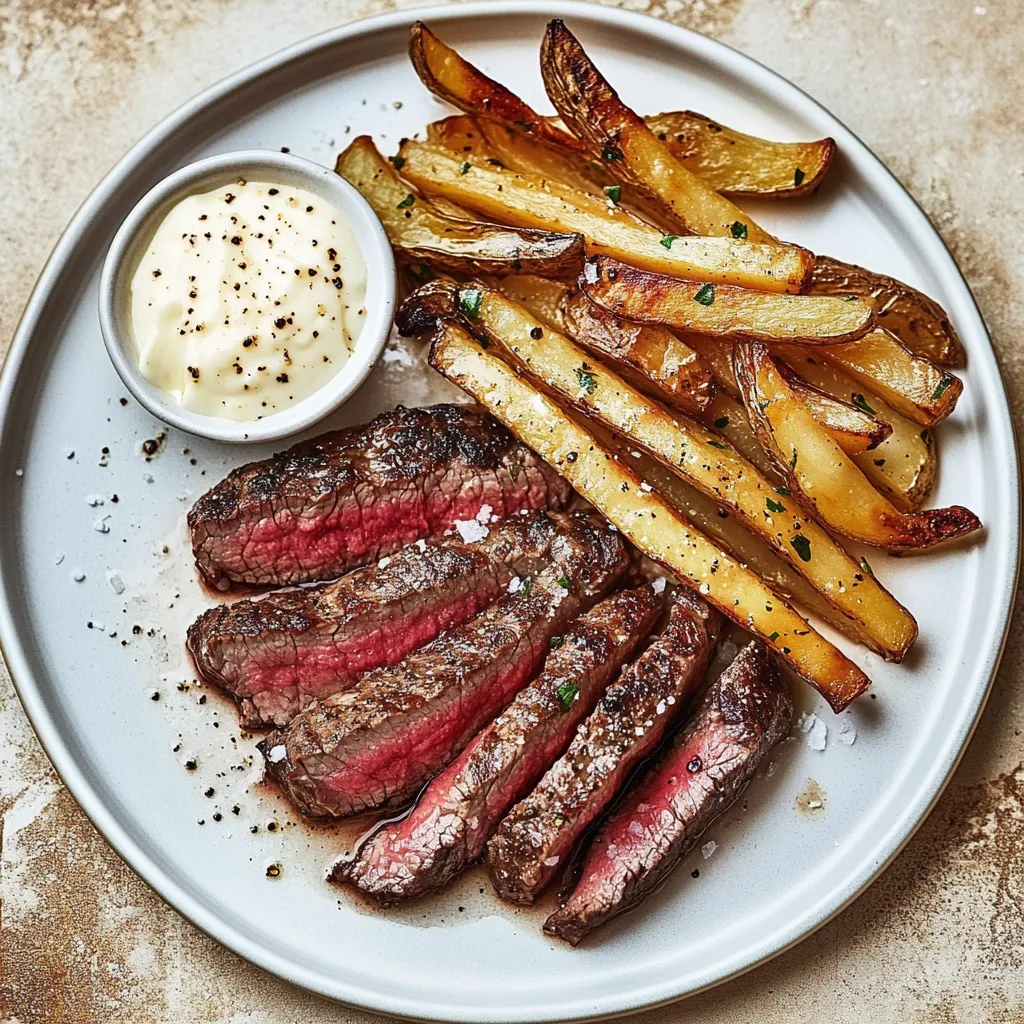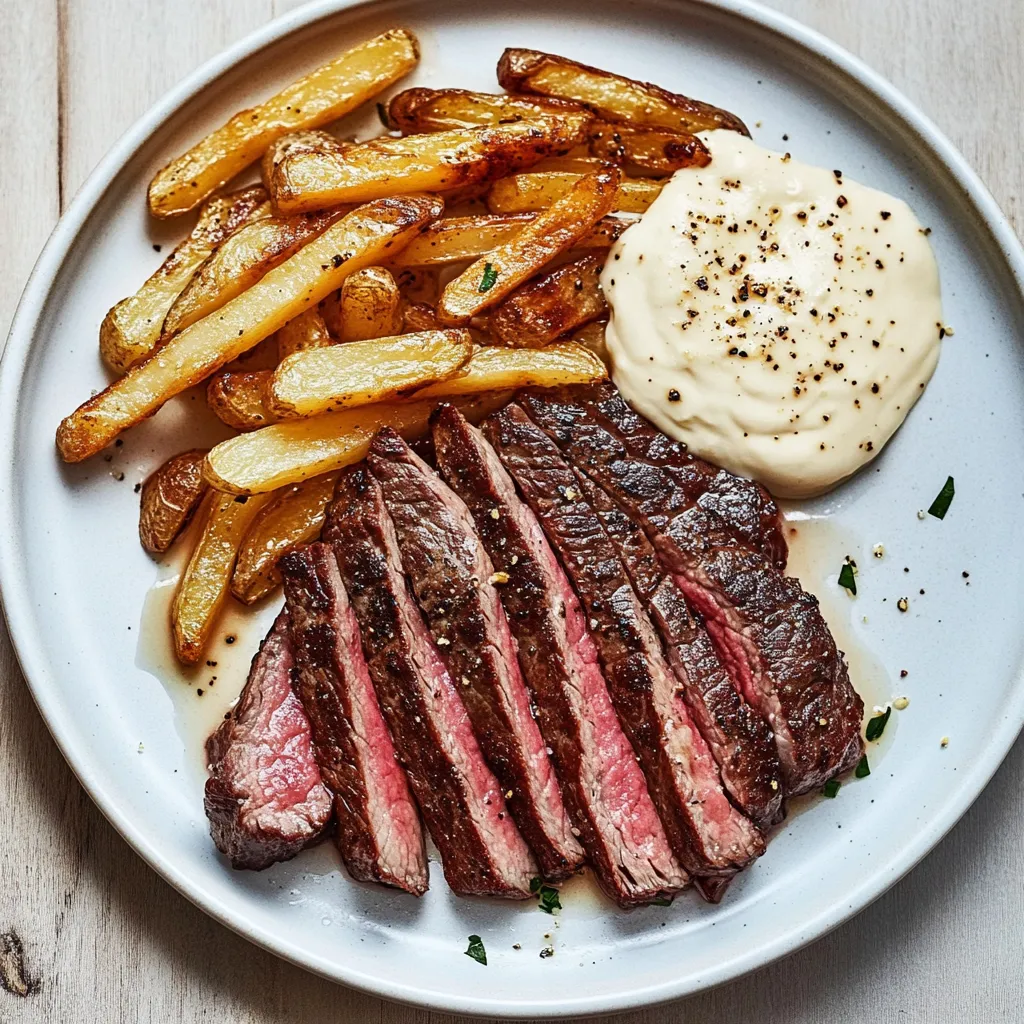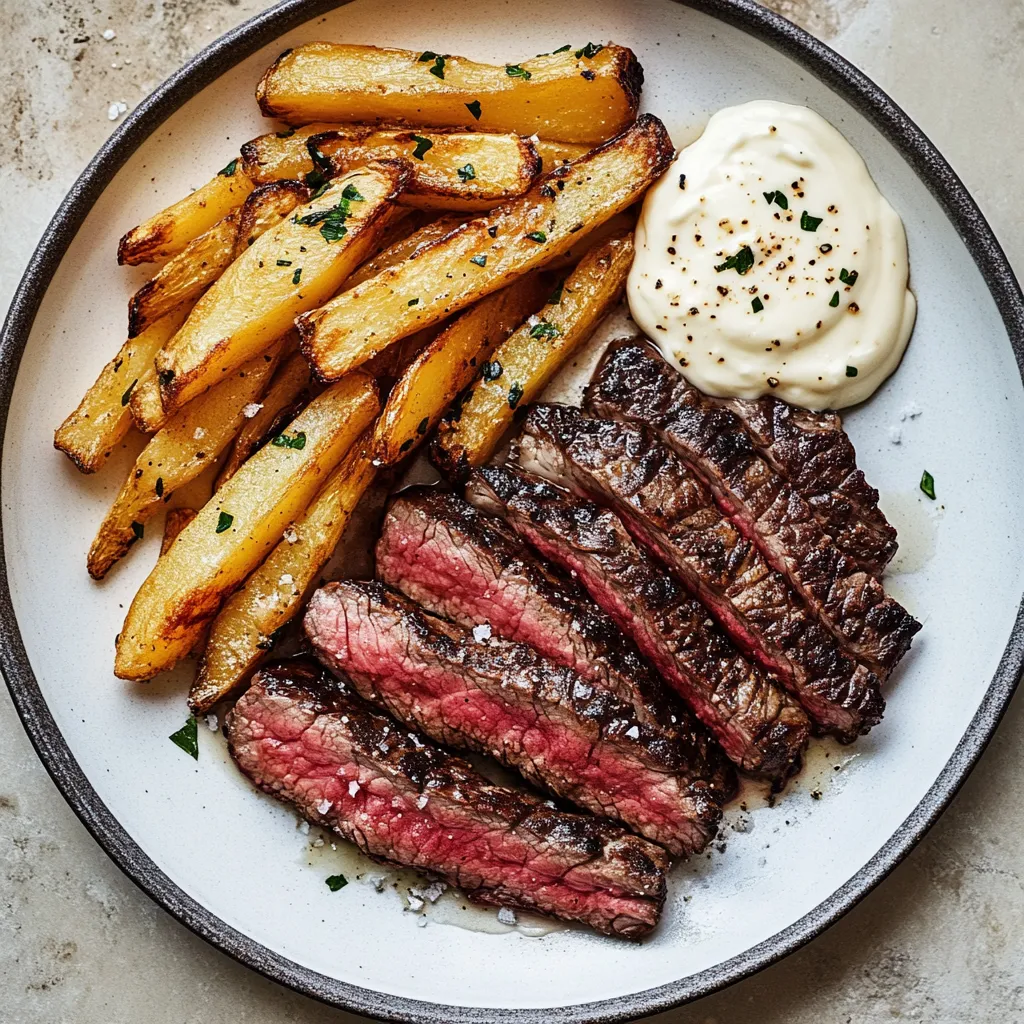 Pin it
Pin it
Pan-searing ribeye steak and double-frying hand-cut potatoes creates the French bistro classic that tastes like you ordered it at a sidewalk café in Paris. The steak gets a beautiful crust on the outside while staying juicy and rare inside, and those twice-fried potatoes develop incredible crispness that store-bought frozen fries never achieve. Garlic aioli served alongside brings everything together with creamy, garlicky richness. This sounds fancy but really just means steak with fries, except when you make it properly at home, it rivals anything you'd pay twenty-five dollars for at a restaurant.
Steak frites became my go-to impressive dinner after realizing the technique is actually straightforward despite sounding sophisticated. The first time I made it, I used frozen fries and wondered why it didn't taste restaurant-quality. Once I committed to cutting and double-frying fresh potatoes, everything changed. That extra step of soaking them in ice water and frying twice creates fries so good that my family now refuses restaurant versions. The ribeye steak with its rich, beefy flavor pairs perfectly with those crispy fries and garlicky aioli, creating a meal that feels special without requiring culinary school skills.
Ingredients and Why They Matter
- Ribeye steaks (2, about 12-16 ounces each, 1-1½ inches thick): Well-marbled cut that stays juicy and flavorful; flank, skirt, hanger, or sirloin substitute but have different textures
- Russet potatoes (4 large): High starch content creates fluffy interiors and crispy exteriors when fried; waxy potatoes stay dense and don't crisp as well
- Refined peanut oil (about 2 quarts for frying): High smoke point makes it ideal for deep frying; vegetable or canola oil work as substitutes
- Extra virgin olive oil (2 tablespoons): For searing the steaks and adding flavor
- Unsalted butter (2 tablespoons): Adds richness while searing steaks; compound butter with herbs elevates this further
- Salt and black pepper (generous amounts): Essential for seasoning both steak and fries properly
- Mayonnaise (½ cup): Base for the quick aioli
- Garlic (2-3 cloves, minced): Provides the signature punch
- Lemon juice (1 tablespoon): Brightens and adds acidity
- Salt (to taste): Enhances all the other flavors
How To Make It
- Rest the steak:
- Remove your ribeye steaks from the refrigerator and place them on a plate at room temperature. Let them sit for 30 minutes before cooking. This step is crucial because cold steak thrown into a hot pan cooks unevenly - the outside burns before the inside warms up. Room temperature steak sears beautifully and cooks evenly throughout. Use this waiting time to prepare the fries. Pat the steaks dry with paper towels right before cooking because surface moisture prevents proper browning.
- Prepare the potatoes:
- Peel the russet potatoes using a vegetable peeler, removing all the skin. Rinse them under cold water to remove any dirt. Cut each potato lengthwise into slices about ¼ to ⅓ inch thick, then cut those slices into sticks of the same width, creating uniform fries. Consistency matters because evenly-sized fries cook at the same rate. Place all the cut fries into a large bowl and cover them completely with ice-cold water. Let them soak for at least 15 minutes, though up to an hour works fine. This soaking removes excess surface starch that would make fries gummy and stick together during frying. The ice-cold water also helps them crisp up better.
- First fry - blanching:
- Heat about 2 quarts of peanut oil in a large, heavy pot or deep fryer to 325°F, checking with a thermometer. Drain the potatoes thoroughly and pat them very dry with clean kitchen towels - any water causes dangerous splattering when it hits hot oil. Working in batches to avoid crowding, carefully lower a handful of fries into the hot oil using a spider strainer or slotted spoon. Fry for about 5-6 minutes, stirring occasionally, until the fries are cooked through and tender but still pale without much color. They shouldn't be golden yet. This first fry cooks the potato interior. Transfer the blanched fries to a paper towel-lined baking sheet to drain. Repeat with remaining potatoes. Let all the fries cool to room temperature, which can take 15-20 minutes. You can do this step up to 4 hours ahead.
- Season and sear the steak:
- Pat your room-temperature steaks completely dry again with paper towels. Season both sides generously with salt and black pepper, pressing the seasonings into the meat so they stick. Heat a large cast-iron skillet or heavy-bottomed pan over high heat until very hot, about 3-4 minutes. Add the olive oil and butter, swirling to coat the pan as the butter melts and foams. Carefully place the steaks in the hot pan - they should sizzle immediately. Don't move them at all for about 4 minutes. This undisturbed time creates a beautiful brown crust. After 4 minutes, flip the steaks using tongs and cook the other side for another 3-4 minutes for medium-rare, or longer for more well-done. Use an instant-read thermometer inserted into the thickest part - you want 130-135°F for medium-rare, 140°F for medium. Remember the temperature will rise 5 degrees during resting.
- Rest the steak:
- Transfer the cooked steaks to a clean cutting board and tent loosely with aluminum foil. Let them rest for 5-10 minutes without cutting into them. This resting period allows juices to redistribute throughout the meat instead of running out when you slice. Cutting immediately creates a pool of juice on the plate and dry steak. While the steak rests, finish the fries.
- Second fry - crisping:
- Increase the oil temperature to 375°F. Working in batches again, carefully add the cooled, pre-fried potatoes back into the hot oil. Fry for 2-3 minutes, stirring occasionally, until deep golden brown and very crispy. The higher temperature and shorter time create that signature crunchy exterior while keeping the interior fluffy. Don't overcrowd or the temperature drops and fries steam instead of crisp. Transfer finished fries to a paper towel-lined plate and immediately season generously with salt while they're still hot so it sticks. Repeat with remaining batches.
- Make the aioli:
- While everything cooks, whisk together the mayonnaise, minced garlic, lemon juice, and a pinch of salt in a small bowl until smooth. Taste and adjust seasoning. The aioli can be made up to 2 days ahead and refrigerated in a covered container. Let it come to room temperature before serving or the flavors taste muted.
- Slice and serve:
- After resting, slice the steak against the grain into strips about ½ inch thick. Slicing against the grain means cutting perpendicular to the muscle fibers, which makes the meat more tender. Arrange the sliced steak on serving plates alongside a generous pile of hot, crispy fries. Serve the garlic aioli in a small bowl for dipping both steak and fries. The combination of juicy steak, crunchy fries, and creamy aioli creates the perfect bite that defines great steak frites.
 Pin it
Pin it
Ribeye steak became my preferred cut after years of using sirloin and being disappointed by dry, chewy results. The marbling in ribeye - those white fat streaks running through the meat - melts during cooking and keeps everything moist and flavorful. Even if I accidentally overcook it slightly, the fat content prevents it from becoming shoe leather. My butcher taught me to look for ribeyes with good marbling throughout rather than choosing the leanest piece, which completely changed how my steaks turned out.
Steak Doneness Guide
- Rare: 120-125°F with a cool red center.
- Medium-Rare: 130-135°F with a warm red center (recommended for ribeye).
- Medium: 140-145°F with a warm pink center.
- Medium-Well: 150-155°F with slightly pink center.
- Well-Done: Exceeds 160°F with no pink remaining.
Remember that carryover cooking increases temperature by about 5 degrees during resting, so remove steak from heat 5 degrees before your target temperature. Invest in a good instant-read thermometer for consistent results.
The Double-Fry Method
Double-frying transforms potatoes from ordinary to extraordinary through a two-stage process. The **first fry at 325°F** cooks the potato interior, making it soft and fluffy while barely coloring the exterior. Cooling between fries allows the interior structure to set. The **second fry at 375°F** happens quickly at high heat, creating a crispy, golden crust without overcooking the now-tender interior. Single-frying can't achieve both goals - either the outside burns before the inside cooks, or the inside cooks but the outside stays pale and soft. This technique is why restaurant fries taste so much better than homemade attempts that skip the double fry.
Aioli Variations
While garlic aioli is classic, simple variations create different flavor profiles. Add a teaspoon of Dijon mustard for **mustard aioli**. Stir in chopped fresh herbs like parsley, tarragon, or chives for **herb aioli**. Mix in a tablespoon of harissa or sriracha for **spicy aioli**. Add lemon zest along with the juice for extra citrus punch. Substitute lime juice for lemon and add cilantro for Latin-inspired aioli. Roast the garlic first for mellower, sweeter flavor. Each variation takes seconds but transforms the accompaniment while keeping the basic technique identical.
Alternative Steak Cuts
While ribeye delivers the richest flavor, other cuts work beautifully for steak frites. **Flank steak** is leaner and benefits from marinating, slicing very thinly against the grain after cooking. **Skirt steak** has great beefy flavor with loose grain that stays tender when cooked rare to medium-rare. **Hanger steak**, sometimes called butcher's steak, offers incredible flavor at a lower price point. **Top sirloin** provides good flavor with less fat than ribeye. **Strip steak** (New York strip) balances marbling and leanness nicely. Each cut requires slight timing adjustments based on thickness, but the cooking method stays the same.
Oil Temperature Control
Maintaining proper oil temperature throughout frying determines success or failure. Too-low temperature causes fries to absorb oil and become greasy instead of crispy. Too-high temperature burns the exterior before the interior cooks. Use a thermometer and check frequently, adjusting heat as needed. Temperature drops when you add potatoes because they're cooler than the oil. Don't add too many fries at once or the temperature plummets. Let oil return to proper temperature between batches. Peanut oil's high smoke point (450°F) makes it ideal because you're frying at 375°F with good margin before it breaks down.
Serving Presentation
French bistros traditionally serve steak frites on heated oval platters with steak sliced or whole, fries piled alongside, and aioli in a small dish. For home serving, warm dinner plates in a low oven so hot food doesn't cool immediately. Arrange sliced steak slightly overlapping on one side. Pile fries generously on the other side or in a separate small basket. Place aioli in a small ramekin or bowl. Garnish with fresh parsley if desired. Serve immediately while steak is still warm and fries are at peak crispness. Have extra napkins ready because this is hands-on, messy eating at its best.
 Pin it
Pin it
This steak frites recipe represents classic French bistro cooking at its most approachable - simple ingredients prepared with proper technique create something that tastes extraordinary. The contrast of perfectly seared, juicy steak with crunchy, golden fries and creamy garlic aioli delivers satisfaction that fancy, complicated dishes rarely achieve. When you serve this and watch people's faces light up at that first bite combining all three elements, you know you've made something special. Sometimes the best meals are the ones that prove simple done well beats complicated done poorly, and steak frites absolutely exemplifies that truth every single time you make it.
Frequently Asked Questions
- → What cut of beef works best for steak frites?
- Ribeye is the top choice because of its marbling and flavor. You can also use strip steak or sirloin if you prefer a leaner cut.
- → Why do you fry the potatoes twice?
- The first fry cooks the potatoes through, and the second fry at higher heat creates that crispy golden exterior. It's the secret to restaurant-quality fries.
- → Can I use a different oil instead of peanut oil?
- Yes, vegetable oil or canola oil work well for frying. Just make sure whatever oil you use has a high smoke point for safe deep frying.
- → How do I know when my steak is done?
- An instant-read thermometer is your best friend. For medium-rare, pull it off at 135°F. The steak will continue cooking a bit as it rests.
- → Do I have to let the steak rest before cutting?
- Yes, resting for 5 to 10 minutes lets the juices redistribute throughout the meat. If you skip this step, all those delicious juices will run out onto your cutting board.
- → What potatoes are best for homemade fries?
- Russet potatoes are ideal because they have high starch content and lower moisture, which means crispier fries. Yukon golds can work in a pinch.
